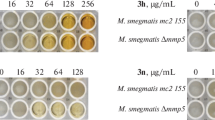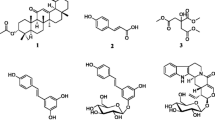Abstract
Metabolism of imazalil (1-[2-(2,4-dichlorophenyl)-2-(2-propenyloxy)ethyl]-1H-imidazole) inPenicillium italicum isolates with a wild-type sensitivity and with various degrees of resistance to sterol demethylation inhibitors was studied in liquid cultures. The metabolite 1-[2(2,4-dichlorophenyl)-2-(2,3-dihydroxypropyloxy)ethyl]-1H-imidazole (R42243) was detected in the culture filtrate after prolonged incubation. The metabolism occurred in the propenyl side chain of imazalil probably through epoxidation and hydratation. This is the first report of such a conversion of imazalil in fungi. R42243 was much less toxic toP. italicum than imazalil. Therefore, the metabolism can be regarded as a detoxification step. Both wild-type and resistant isolates metabolized imazalil, but metabolism by resistant isolates was faster than by the wild-type isolate. This is probably caused by a relatively strong inhibition of growth of the wild-type isolate by the fungicide. Results indicate that the detoxification of imazalil does not operate as a mechanism of resistance. This conclusion was confirmed by the fact that resistant isolates showed cross-resistance to miconazole and R42243, which had a similar structure as imazalil except for the propenyl side chain.
Similar content being viewed by others
References
Cano, M. P., De la Plaza, J. L. & Munoz-Delgado, L., 1987. Determination and persistence of imazalil in post-harvest-treatment apples during cold storage. Pesticide Science 19: 283–287.
Deas, A. H. B., 1986. Triadimefon: relationship between metabolism and fungitoxicity. Pesticide Science 17: 69–90.
Deas, A. H. B. & Clifford, D. R., 1981. Metabolism of the 1,2,4-triazolymethane fungicides, triadimefon, triadimenol and diclobutrazol byAspergillus niger (van Tiegh). Pesticide Science 17: 120–133.
Dekker, J., 1987. Development of resistance to modern fungicides and strategies for its avoidance. In: Lyr, H. (Ed.), Modern Selective Fungicides. VEB Gustav Fischer Verlag, Jena, FRG, p. 39–52.
De Waard, M. A., Groeneweg, H. & Van Nistelrooy, J. G. M., 1982. Laboratory resistance to fungicides which inhibit ergosterol biosynthesis inPenicillium italicum. Netherlands Journal of Plant Pathology 88: 99–112.
De Waard, M. A. & Van Nistelrooy, J. G. M., 1990. Stepwise development of laboratory resistance to DMI fungicides inPenicillium italicum. Netherlands Journal of Plant Pathology 96: 321–329.
De Waard, M. A. & Van Nistelrooy, J. G. M., 1988. Accumulation of SBI fungicides in wild-type and fenarimol-resistant isolates ofPenicillium italicum. Pesticide Science 22: 371–382.
Fuchs, A., 1988. Implications of stereoisomerism in agricultural fungicides. In: Ariëns, E. J., Van Rensen, J. J. S. & Welling, W. (Eds) Stereoselectivity of Pesticides, Biological and Chemical Problems. Elsevier, Amsterdam, The Netherlands, p. 203–262.
Fuchs, A. & De Vries, F. W., 1984. Diastereomer-selective resistance inCladosporium cucumerinum to triazole-type fungicides. Pesticide Science 15: 90–96.
Gasztonyi, M. & Josepovits, G., 1975. Biochemical and chemical factors of selective antifungal effect of triforine. I. The causes of selectivity of the contact fungicidal action. Acta Phytopathogica Academiae Scientiarum Hungaricae 10: 437–446.
Gasztonyi, M. & Josepovits, G., 1979. The activation of triadimefon and its role in the selectivity of fungicide action. Pesticide Science 10: 57–69.
Gasztonyi, M. & Josepovits, G., 1984. Metabolism of some sterol inhibitors in fungi and higher plants, with special reference to the selectivity of fungicidal action. Pesticide Science 15: 48–55.
Guan, J., Kerkenaar, A. & De Waard, M. A., 1989. Effects of imazalil on sterol composition of sensitive and DMI-resistant isolates ofPenicillium italicum. Netherlands Journal of Plant Pathology 95 (Suppl. 1): 73–86.
Heykants, J., 1978. On the metabolism of imazalil and related compounds in animals and man. A review. Preclinical Research Report, Janssen Pharmaceutica, Beerse, Belgium, No. R23979/13.
Kalamarakis, A. E., Ziogas, B. N. & Georgopoulos, S. G., 1986. Resistance to ergosterol biosynthesis inhibitors inNectria haematococca. In: Abstracts of 6th International Congress on Pesticide Chemistry, IUPAC, Ottawa, Canada, 3E-06.
Lyr, H., 1987. Selectivity in modern fungicides and its basis. In: Lyr, H. (Ed.): Modern Selective Fungicides. VEB Gustav Fischer Verlag, Jena, FRG, p. 31–38.
Vonk, J. W. & Dekhuijzen, H. M., 1979. Transport and metabolism of [3H]imazalil in barley and cucumber. Mededelingen Faculteit Landbouwwetenschappen Rijksuniversiteit Gent 44: 927–934.
Author information
Authors and Affiliations
Rights and permissions
About this article
Cite this article
Guan, J., Van Leemput, L., Posthumus, M.A. et al. Metabolism of imazalil by wild-type and DMI-resistant isolates of Penicillium italicum. Netherlands Journal of Plant Pathology 98, 161–168 (1992). https://doi.org/10.1007/BF01974379
Accepted:
Issue Date:
DOI: https://doi.org/10.1007/BF01974379




